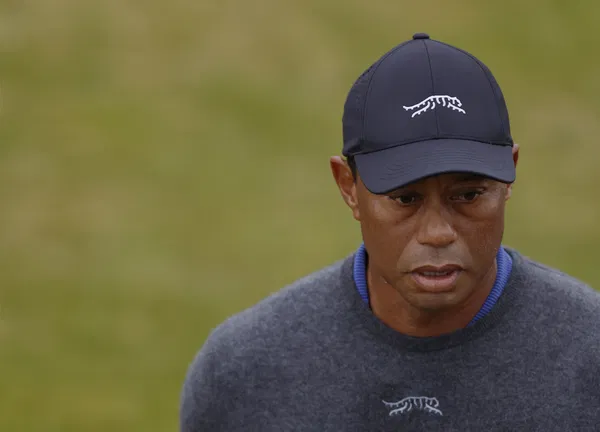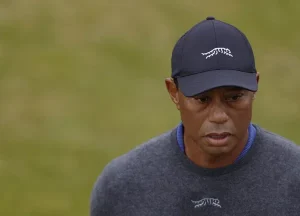
The third men’s major, the U.S. Open, is almost upon us; however, there’s little sign of Tiger Woods. In fact, there’s none. The golfer, having undergone Achilles surgery, has missed the 2025 season so far. In 2024, he played in all four majors and missed the cut in three. Additionally, he recorded his career-worst score at the Masters (16-over 304). Given his lack of presence and poor performance, the golfer has fallen to his career worst OWGR: 1,341. However, his performance has been affected by both the surgeries and injuries—especially the one he dealt with in 2013.
The story starts with The Barclays 2013 week. On Wednesday, Woods reported a sore back after he cut his pro-am short, blaming it on a soft hotel bed. During the final round at The Barclays on Sunday, he was near the lead, but after his second shot on the par-5 13th hole, he fell in pain. He ended up T-2, just one stroke behind Adam Scott, with the injury costing him the tournament. The injury affected him over 12 years ago; however, even now, when Tiger Woods thinks of that moment, he cannot help but admit the sheer “hurt” he felt that day.
During an interview with Rolex, Woods talked about the injury: “Yeah, Barclays in 2013. That hurt. That’s basically when I broke my back. As a golfer, the last thing you want to happen is a back injury. But that moment, it just went. Just that burning and the pain, the searing pain, it felt like it was on fire. That was a very dark and difficult time. Forget playing golf, forget playing a tour or winning major championships. I couldn’t function in society, I couldn’t get to the bathroom, walk, I was laying on the ground, I couldn’t do anything.”
Do you think Tiger Woods should continue competing despite his ongoing injury struggles?
Yes, his resilience is inspiring
No, he should prioritize his health
Only if he can compete at a high level
It’s time for him to retire gracefully
Back spasms can be extremely painful, causing sudden, sharp pain that radiates through the back and legs, which severely limits mobility and makes simple tasks like standing, sitting, or bending nearly impossible. Given the severity of the back spasms, Woods had to eventually pull out of his friend Notah Begay’s charity event.
However, Tiger Woods has faced this challenge several times, having undergone six back surgeries from 2004 to 2024, including his first spinal fusion surgery in 2017. Tiger Woods’s spinal fusion surgery in April 2017 marked a pivotal moment in his career, enabling him to recover from severe injuries that had threatened his future in golf. In a video by Centinel Spine, Woods described the intense pain he endured while playing, likening it to the discomfort of hitting your funny bone repeatedly throughout the day. Initially, Woods viewed the surgery as a potential end to his career.
To Woods’s relief, the nerve pain in his right leg, which had plagued him for years, vanished, setting the stage for his remarkable comeback. In fact, it was after this injury that he registered his 15th major title at the 2019 Masters. Perhaps that’s what Tiger Woods finds the beauty of golf in–“earning it through the dirt.” In the Rolex interview, he continued, “That’s just part of my DNA is to go out there and fight and earn it. That’s how I was raised, picking yourself up, doing it again and again and again and again and again. And when you’re tired, do it again.” And he showcased that at the 2008 U.S. Open.
Does Tiger Woods’ 2008 U.S. Open win on one leg make him the greatest golfer of all time?
Tiger Woods’s “one-legged” major win at the 2008 U.S. Open
The U.S. Open in 2008 marked a decade since Tiger Woods triumphed at Torrey Pines. Despite battling severe injuries, including two stress fractures and a torn ACL in his left knee. This tournament served as a grueling test of endurance, culminating in a Monday playoff against Rocco Mediate, who aimed to become the oldest U.S. Open champion.
Woods visibly struggled throughout the tournament, often clutching his knee in pain. He underwent knee surgery just days after finishing second at the Masters and kept the severity of his injuries largely secret. Despite doctors advising him to skip the Open, Woods remained determined to compete, famously stating, “I could never quit in front of these people—it was never going to happen.”
He showcased his resilience in the second round by shooting a remarkable 30 over nine holes, which left him just one shot off the lead. His performance peaked in the third round with a stunning eagle on the 18th hole, giving him a one-stroke lead heading into the final round. However, the final day was tense as he struggled to maintain his lead, ultimately forcing a playoff with a clutch birdie putt on the 72nd hole. In the playoff, Woods demonstrated his tenacity by overcoming a challenging start to secure victory. After Mediate faltered, Woods sealed the win with a par on the 19th hole, declaring it “probably the greatest tournament I’ve ever had.” This iconic win, achieved on one leg, solidified Woods’ legacy.







